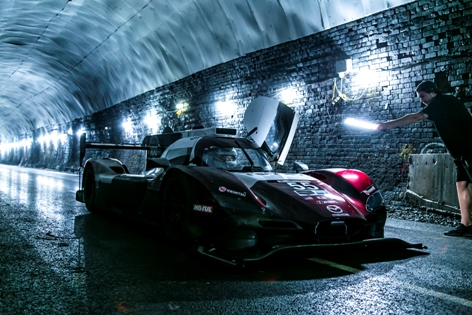A Victorian railway tunnel has been repurposed to provide the UK with its first full size aerodynamic test facility
Multimatic Motorsports has completed an initial aerodynamic evaluation test at Catesby Tunnel, a newly-opened aerodynamic testing facility, owned by ARP (Aero Research Partners), which is the first facility of its kind in the UK and only the second in the world.
In order to perform a full correlation check, the team ran its Mazda DPi racing car through the tunnel at speeds of up to 120mph, comparing the results to a comprehensive set of data previously gathered from 40% scale and full-size wind tunnel testing, as well as Computational Fluid Dynamics development and five years of competition in IMSA’s top level championship. Initial results indicate a high level of correlation to that existing performance data.
Historic Tunnel
The Catesby facility began its life as a dual rail Victorian railway tunnel, with the first steam locomotives running through it in July 1898. The tunnel still carries vestiges of soot from the coal burning trains, which has stuck to many of the approximately 30 million bricks that were required to construct the perfectly straight 2.7 km long tunnel, boasting a massive cross-section, 8.2m wide and 7.8m high. It closed to trains in 1966 and now a multi-million-pound transformation has turned Catesby into a state-of-the-art aerodynamic vehicle testing facility.
Located just a few miles from Daventry in rural Northamptonshire, Catesby tunnel is ideally situated in the heart of the UK’s automotive research and autosport industrial cluster.
A step beyond wind tunnels
Catesby Tunnel turns the traditional practice of using a wind tunnel on its head, believes Multimatic Motorsports boss, Larry Holt. He says that compared to conventional wind tunnels, this is better because it’s a real situation in contrast to a moving ground plane wind tunnel, in which the car is stationary and the wind is blown over it by a massive fan and flow conditioning set-up, and a belt is arranged to move under the car at a coordinated speed. Althought it’s a very sophisticated configuration, the car is still stationary and so not fully replicating a real situation. In contrast, what Catesby facilitates is the measurement of the aerodynamic performance of a vehicle actually moving through the real world.
“The problem with a car moving through the real world is that it is subjected to influences like gusting wind, rain and other changing environmental conditions that effect air density; all of the variables that come with testing in the real world. Catesby provides the real world without the weather. You have a moving car, a real road surface, a controlled environment and we can run 24 hours a day, whatever the season. It is a perfect 2.7kms of controlled atmosphere. That’s the kind of consistency you need when you are chasing incremental gains,” explains Holt.
Multimatic driver, Andy Priaulx, was behind the wheel of the Mazda RT24-P throughout the initial test. According to him, he’s used to engineers studying static car models in wind tunnels with no involvement from the drivers.
“At the start, it felt a little odd to drive flat out through a 2.7km tunnel, but the team assured me that the end was very clearly marked! Catesby Tunnel is an incredible facility and it doesn’t surprise me at all to know that Multimatic chose to be an early adopter and primary client of the facility,” he says.
- UK manufacturing steps up to COVID-19 crisis - April 2, 2020
- Clustering Innovation - March 12, 2020
- A Global Monitor - March 6, 2020

